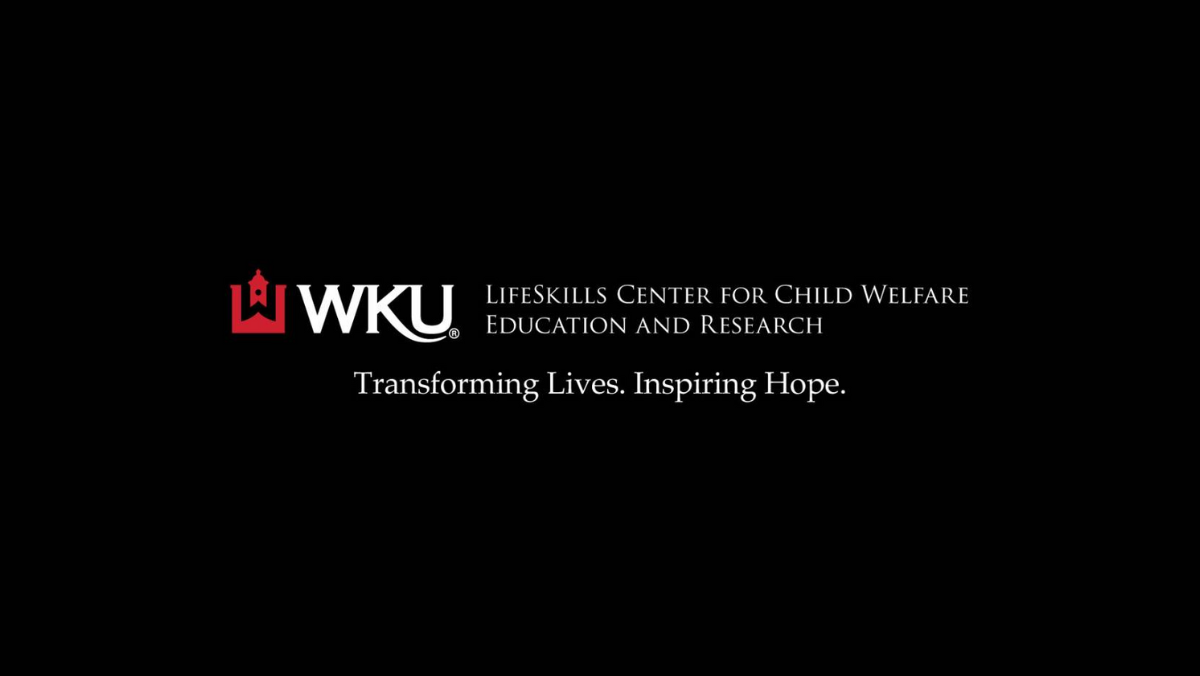
Publications
The Evolving Role of Technology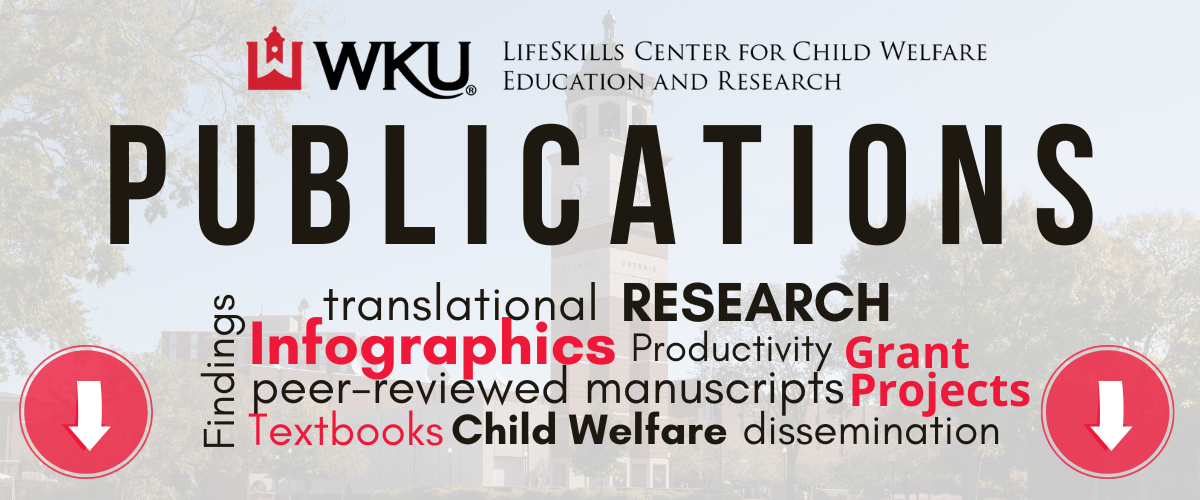
In this section of our website we will highlight the recent productivity of the LifeSkills Center for Child Welfare Education and Research with respect to publications. With a primary focus on the dissemination of translational research, we are making creative efforts to share our research findings with the community. For example, each of the peer-reviewed publications below includes a comprehensive infographic that is a simple and informative avenue for illustrating key aspects and findings. LCCWEAR believes that the innovative dissemination of research findings is an important step forward and as we build we are working to create a more advanced infrastructure to share the findings of our important work. If you have any suggestions for improving this important aspect of our mission, please contact:
Austin Griffiths, PhD, CSW, MSW
Director, LCCWEAR
(270) 745-2676

This article describes the lessons learned and process evaluation of the Kentucky Child Welfare Workforce Wellness Initiative (KCWWWI). The project aimed to better understand the effects of job-related stress on frontline child welfare workers (FCWWs) and improve health and wellness through improved stress management. FCWWs participated in a quasi-experimental pre-test/post study which included a mindfulness-based intervention and biometric data collection. Lessons learned from the KCWWWI can benefit future researchers in implementing health promotion programs for FCWWs.
Haughtigan, K. S., Griffiths, A., Link, K., Beer, O., & Powell, L. (2023). Lessons learned: Facilitating a health and wellness intervention for frontline child welfare workers during COVID-19. Child Welfare, 101(4), 31-51.
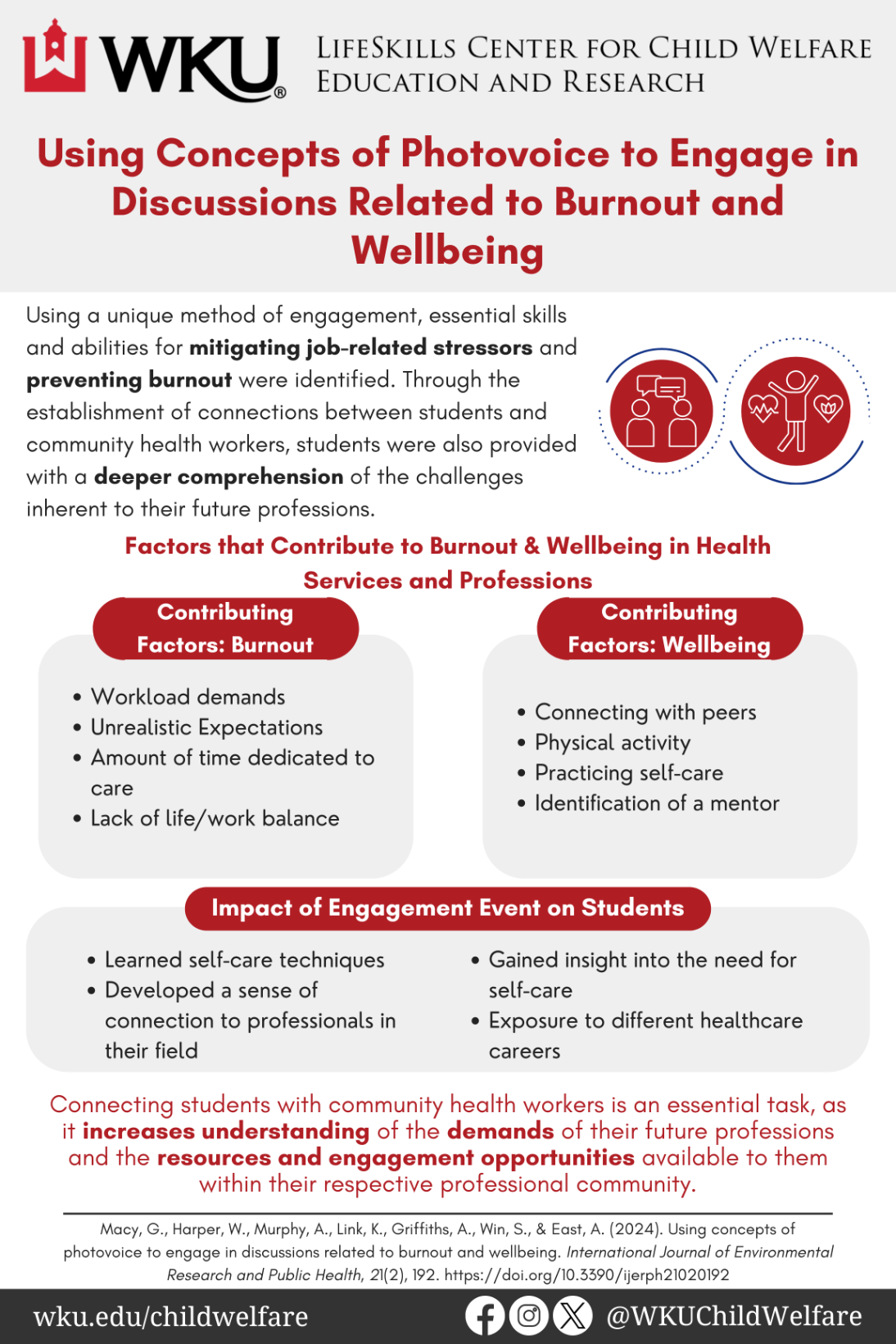
The purpose of this study was to identify essential skills and abilities for mitigating job related stressors and preventing burnout while also establishing connections between students and community health workers to provide students with a deeper comprehension of the challenges inherent to their future professions. Ten community health workers were interviewed and asked to present photographs that explored sources of burnout and promotions of well-being. The photographs along with quotes were displayed in a gallery style exhibit for students to view and talk with the community health workers and complete a survey. Using thematic analysis, the interviews resulted in four common factors that contribute to burnout: (1) workload demands, (2) unrealistic exceptions, (3) amount of time dedicated to care, and (4) lack of work–life balance. The themes that emerged from student responses were (1) learning self-care practices, (2) gaining insight into the need for self-care, (3) a sense of connection, and (4) exposure to different healthcare careers. This study demonstrates the importance of connecting students with community health workers. It increases understanding of the demands of their future professions as well as resources and engagement opportunities available to them as a part of their respective professional community.
Macy, G., Harper, W., Murphy, A., Link, K., Griffiths, A., Win, S., & East, A. (2024). Using concepts of photovoice to engage in discussions related to burnout and wellbeing. International Journal of Environmental Research and Public Health, 21(2), 192.
https://doi.org/10.3390/ijerph21020192
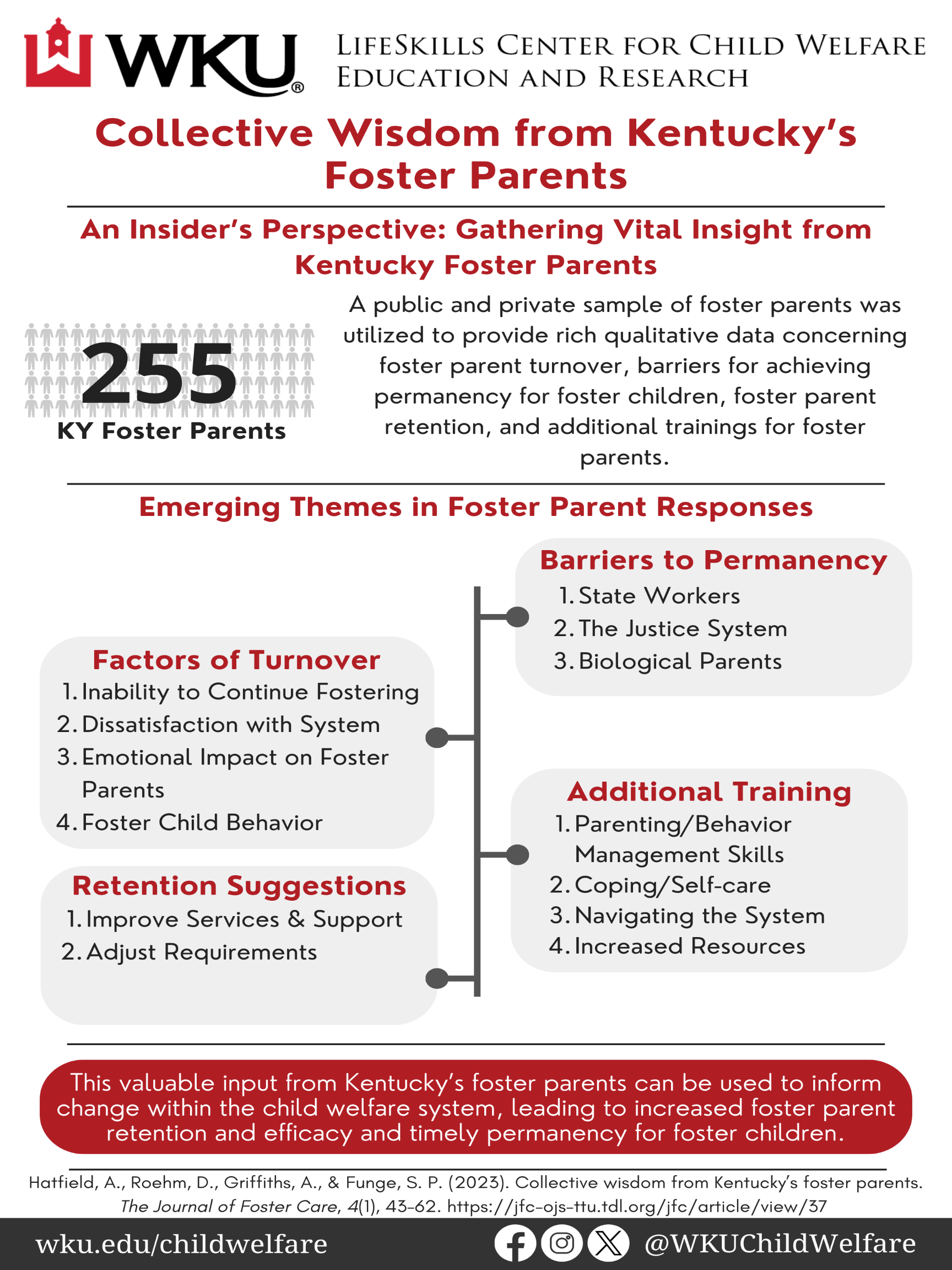
Foster parents serve an integral role in the lives of children every day. In this article, qualitative data from a statewide sample of foster parents from both public and private agencies offered insight into the reasons that they may leave the agency, barriers they reported as influencing the timely permanency of children in care, ideas for the retention of foster parents, and specific requests for additional training. A thematic analysis revealed the inability to continue, various dissatisfactions, and the related emotional impact as key factors that would result in their positions. Foster parents identified challenges with state’s child welfare workers and the justice system as the main barriers that are keeping children in care from achieving timely permanency. Additionally, they requested increased services and support, and they gave examples of additional trainings that would improve their effectiveness as foster parents (e.g., behavior management skills and self-care techniques). The present provides a thorough exploration of these important areas, as foster parents share their wisdom and contribute potential solutions to issues that have long been faced by the child welfare system. Limitations and conclusions are discussed.
Hatfield, A., Roehm, D., Griffiths, A., & Funge, S. P. (2023). Collective wisdom from Kentucky’s foster parents. The Journal of Foster Care, 4(1), 43-62. https://jfc-ojs-ttu.tdl.org/jfc/article/view/37
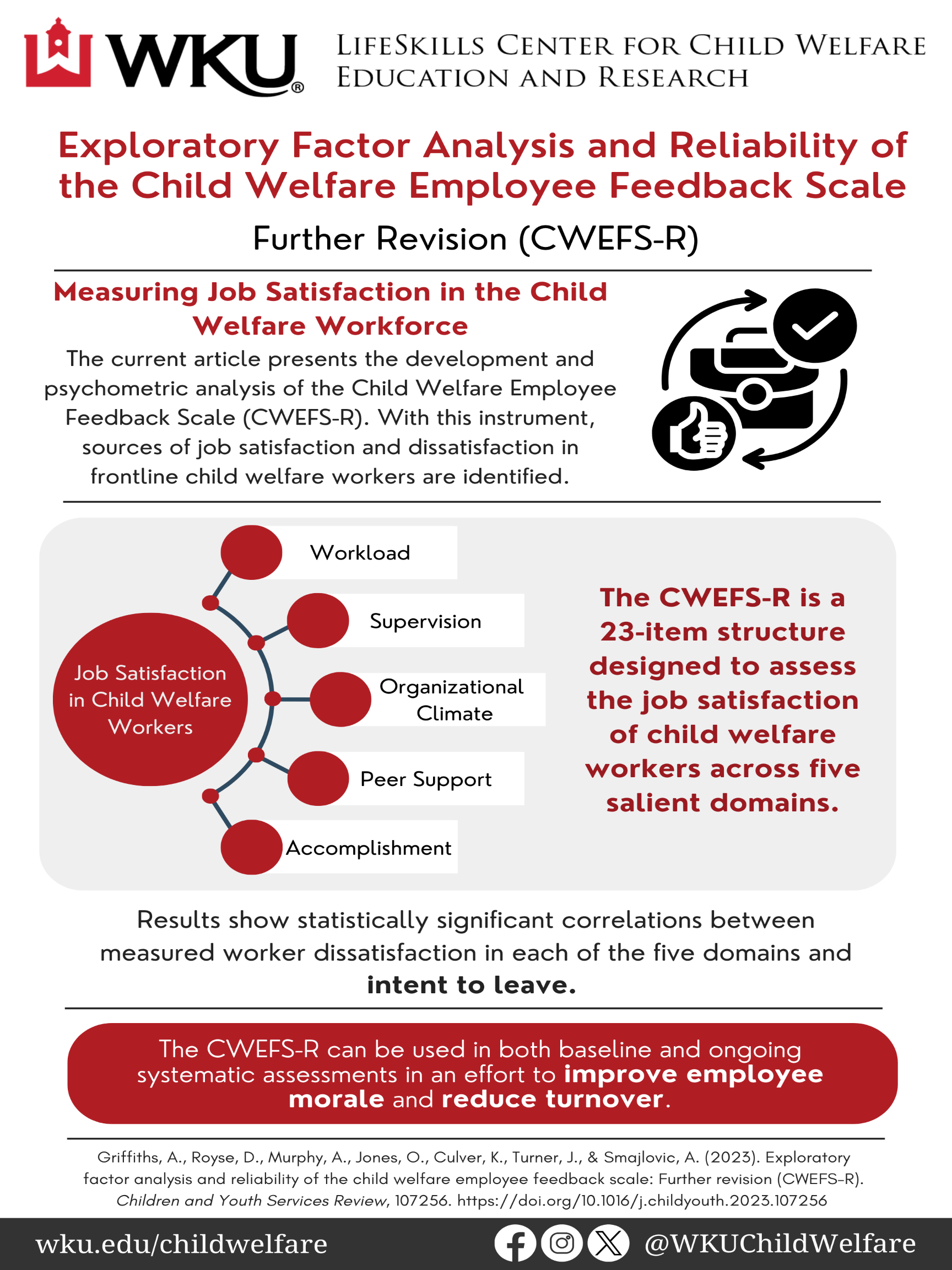
Child welfare workers remain dedicated to the service and safety of families and children, despite decades of high rates of turnover and the consequential impact. Developing and obtaining practical tools to proactively engage the workforce and offset these challenges is a necessity. This article will present the development and psychometric analysis of the Child Welfare Employee Feedback Scale (CWEFS-R). Based on a sample of 511 frontline child welfare workers in one midwestern state, an exploratory factor analysis (EFA) yielded a five-factor structure: (1) workload; (2) supervision; (3) organizational climate; (4) peer support; and (5) accomplishment. Further, criterion validity showed statistically significant correlations in the anticipated direction with each of the five subscales and Intent to Leave. Practice implications are discussed.
Griffiths, A., Royse, D., Murphy, A., Jones, O., Culver, K., Turner, J., & Smajlovic, A. (2023). Exploratory factor analysis and reliability of the child welfare employee feedback scale: Further revision (CWEFS-R). Children and Youth Services Review, 107256. https://doi.org/10.1016/j.childyouth.2023.107256
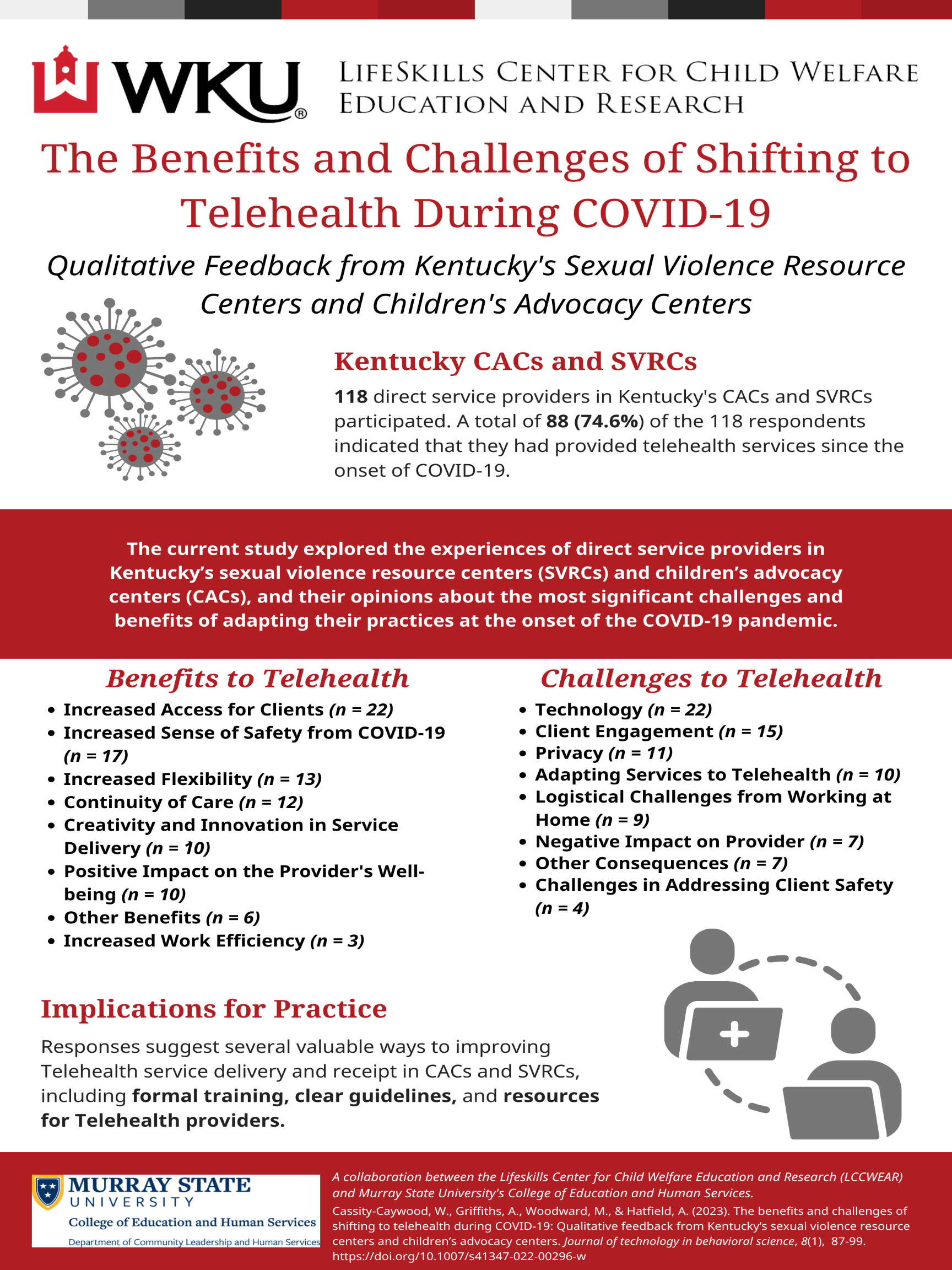
The onset of the COVID-19 pandemic presented novel challenges for service providers addressing mental health issues with a large shift to the utilization of telehealth. While previous research has examined the benefits and challenges of providing mental health and crisis services remotely through telehealth, little research exists examining the use of telehealth in children’s advocacy centers (CACs) and sexual violence resource centers (SVRCs). CACs and SVRCs are multi-disciplinary agencies taking a holistic approach to addressing interpersonal violence, making them unique in that they provide a range of direct services beyond mental health counseling (e.g., legal advocacy, medical exams, and prevention education) but all geared toward public health and safety. The current study explored the experiences of direct service providers in Kentucky CACs and SVRCs and their opinions about the most significant challenges and benefits of adapting their practices at the onset of the COVID-19 pandemic. A total of 118 providers participated in the study, and 88 reported using telehealth (defined as communicating with clients via technology such as videoconferencing, phone calls, or email) since the onset of COVID-19. Qualitative data from those 88 respondents regarding the challenges and benefits of using telehealth were collected and coded using a thematic content analysis. 78.6% of the sample indicated that they served primarily rural areas. Benefits noted included increasing treatment access, increasing treatment flexibility, and advancing continuity of care, while challenges included difficulties with technology, client engagement, privacy, and logistical challenges. Responses highlighted that telehealth presented both a number of advantages and difficulties and that more formal guidance for providers at CACs and SVRCs was desired.
Cassity-Caywood, W., Griffiths, A., Woodward, M., & Hatfield, A. (2023). The benefits and challenges of shifting to telehealth during COVID-19: Qualitative feedback from Kentucky’s sexual violence resource centers and children’s advocacy centers. Journal of technology in behavioral science, 8(1),87-99. https://doi.org/10.1007/s41347-022-00296-w
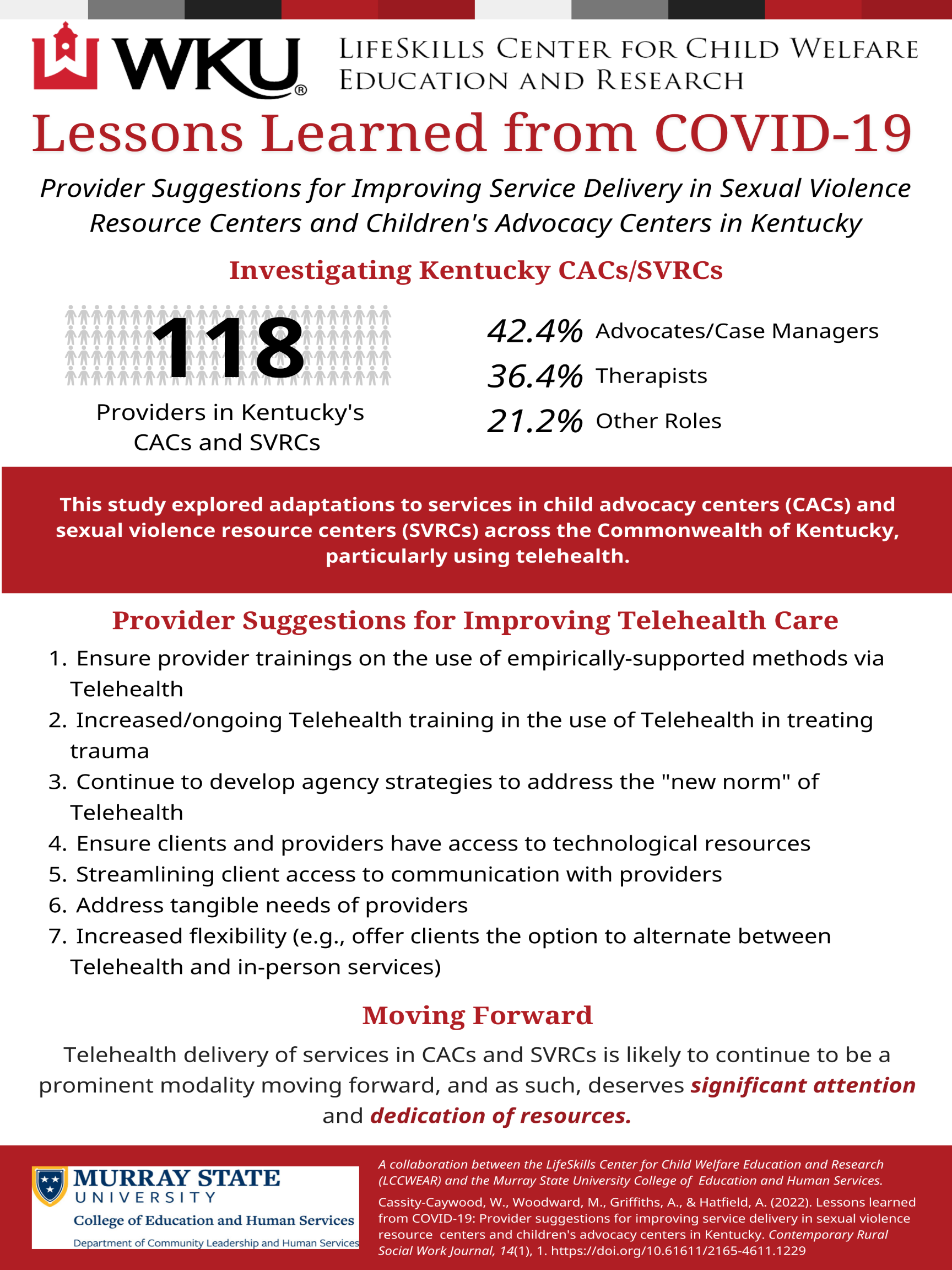
The COVID-19 pandemic has presented unique challenges for human service providers,
especially as face-to-face services were limited by both formal and informal efforts
to protect public health. Telehealth has emerged as a main strategy to ensure continuity
of care. This study explored adaptations to services in child advocacy centers (CACs)
and sexual violence resource centers (SVRCs) across the Commonwealth of Kentucky,
particularly using telehealth. This study highlights respondents’ suggestions about
improving these service delivery
systems and the particular emphasis on challenges and strengths of telehealth for
reaching those in rural areas.
Cassity-Caywood, Whitney; Woodward, Matthew; Griffiths, Austin; and Hatfield, Alecia (2022) "Lessons Learned from COVID-19: Provider Suggestions for Improving Service Delivery in Sexual Violence Resource Centers and Children's Advocacy Centers in Kentucky," Contemporary Rural Social Work Journal: Vol. 14: No. 1, Article 1. DOI: https://doi.org/10.61611/2165-4611.1229
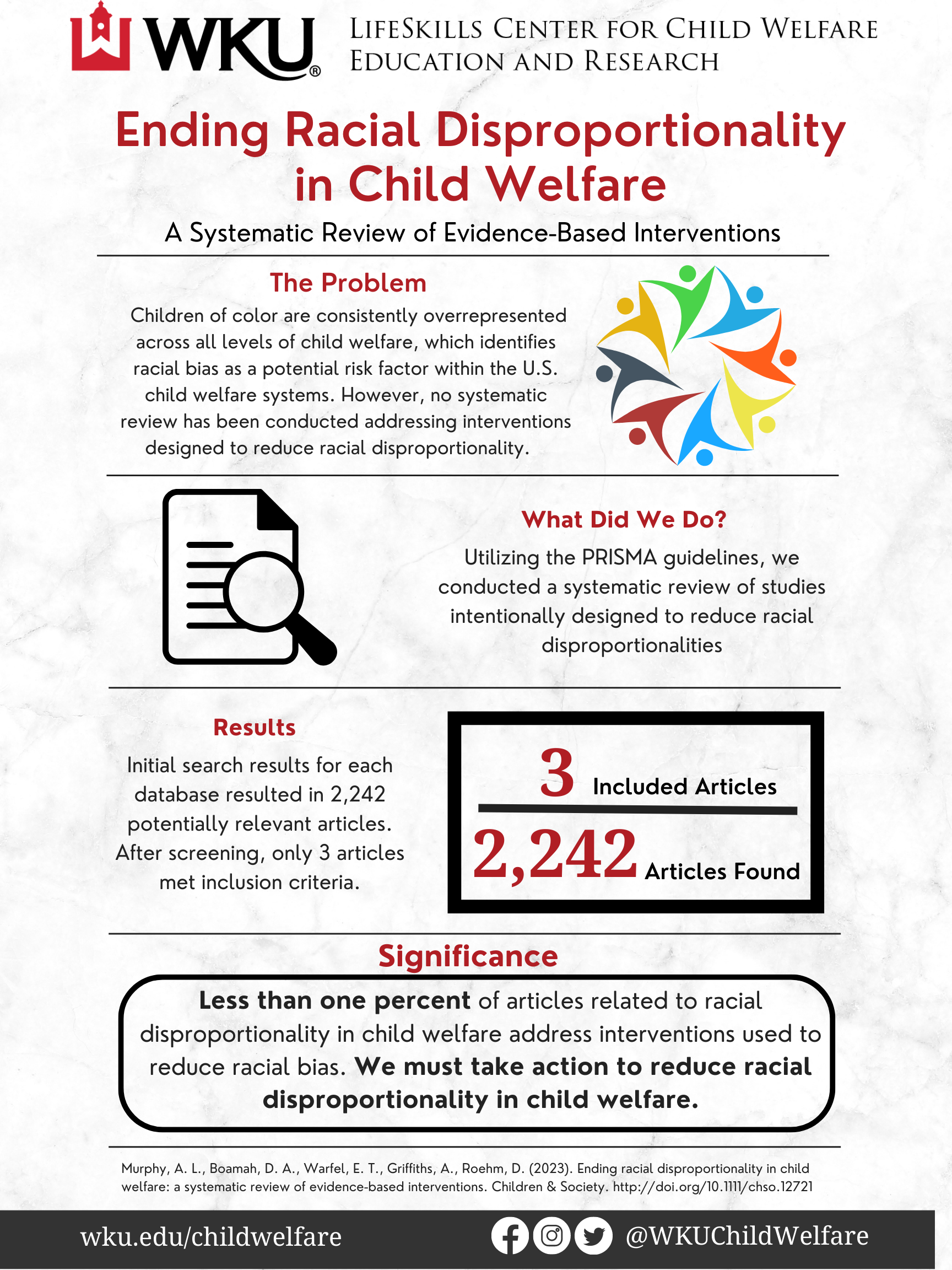
Children of colour, especially non-Hispanic Black, non-Hispanic Native American, and non-Hispanic multiracial, continue to be overrepresented across every decision point in the U.S. child welfare system. Exist-ing research has largely focused on documenting the existence of disproportionality, while there has been less focus on interventions and/or approaches specifi-cally designed to reduce this social problem. This study sought to identify and characterize interventions and/or approaches utilized in child welfare for reducing racial disproportionality by conducting a systematic review following PRISMA guidelines. After reviewing over 1000 studies across eight databases, only three studies met criteria for inclusion in this systematic review. The arti-cles all addressed prevention strategies aimed to address risk factors and subjectivity, while employing interven-tions across both family and organizational/community levels. Three themes emerged, community-wide targeted intervention, culturally responsive family preservation, and agency-specific initiatives, which captured the scope of intervention to the extent as possible. Results indi-cated that training, collaboration, and comprehensive reform are promising, yet large-scale systemic efforts must take priority for meaningful change to occur.
Murphy, A. L., Boamah, D. A., Warfel, E. T., Griffiths, A., & Roehm, D. (2023). Ending racial disproportionality in child welfare: A systematic review. Children & Society, 1. https://doi.org/10.1111/chso.12721
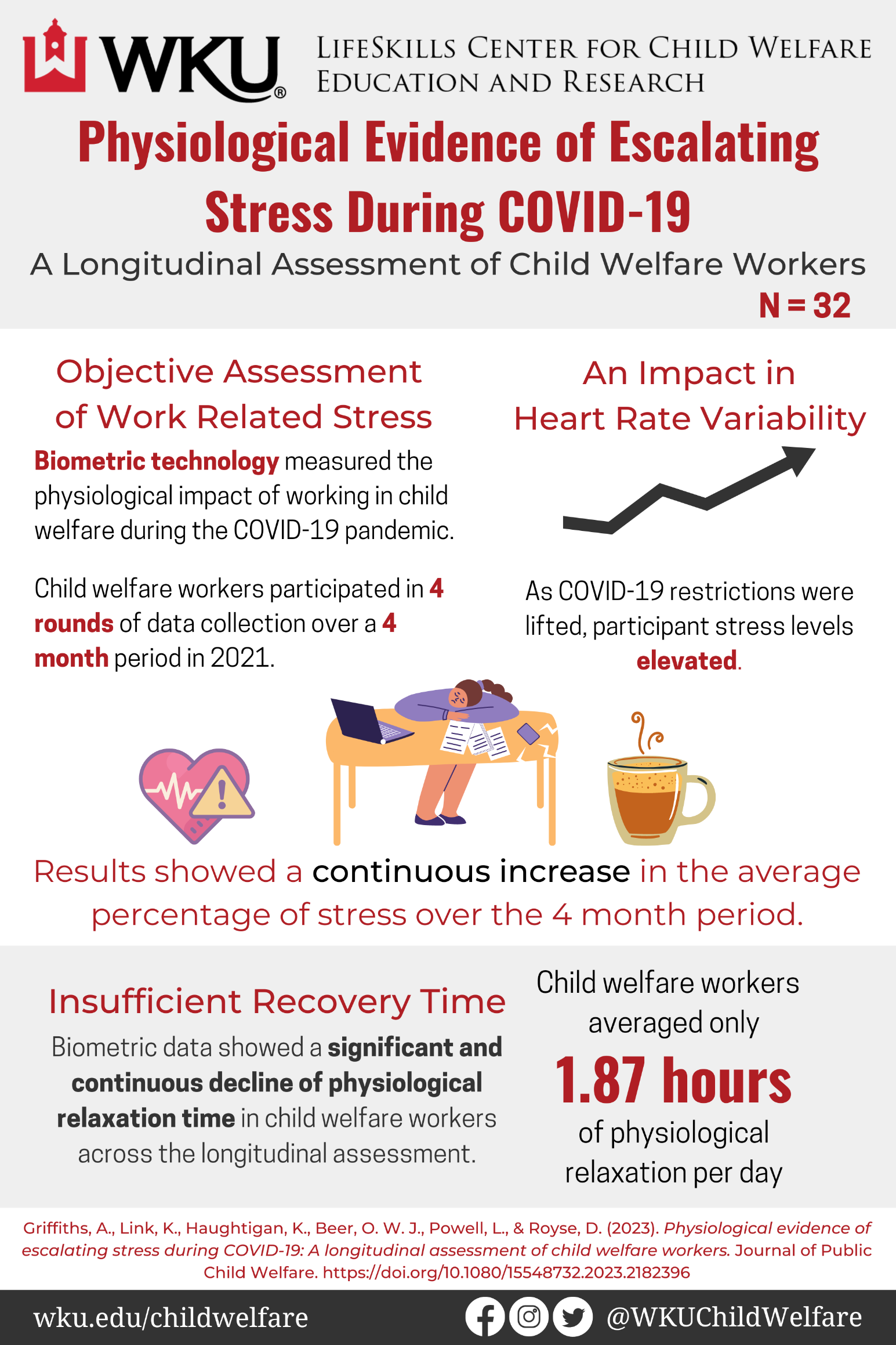
Studies have shown that stress has contributed to employee turnover and retention problems for agencies, and at the individual level, chronic stress has been associated with coronary heart disease, anxiety, depression, and many other negative effects. In the past, the extent of stress one has felt has been measured by subjective paper-and-pencil instruments; however, recent technological advances have improved our ability to obtain accurate biofeedback assessments from wearable instruments. The Kentucky Child Welfare Workforce Wellness Initiative is the first known study to explore physiological stress in a sample (n = 32) of child welfare professionals using biometric technology (Firstbeat Bodyguard 2) and the first to report that data longitudinally over a four-month period. The study revealed that a variable associated with the strength of the Autonomic Nervous System (RMSSD) remained below the norms for a healthy population as participants experienced consistent and prolonged physiological stress. When examined relatively to the agency’s lifting of COVID restrictions and returning to face-to-face service delivery, stress levels began to further rise almost to significant levels (p < .10) and the participants’ ability to achieve a state of physiological relaxation significantly decreased. Future research employing biometric technology is also suggested.
Griffiths, A., Link, K., Haughtigan, K., Beer, O.W.J., Powell, L., & Royse, D. (2023). Physiological evidence of escalating stress during COVID-19: A longitudinal assessment of child welfare workers. Journal of Public Child Welfare. https://doi.org/10.1080/15548732.2023.2182396
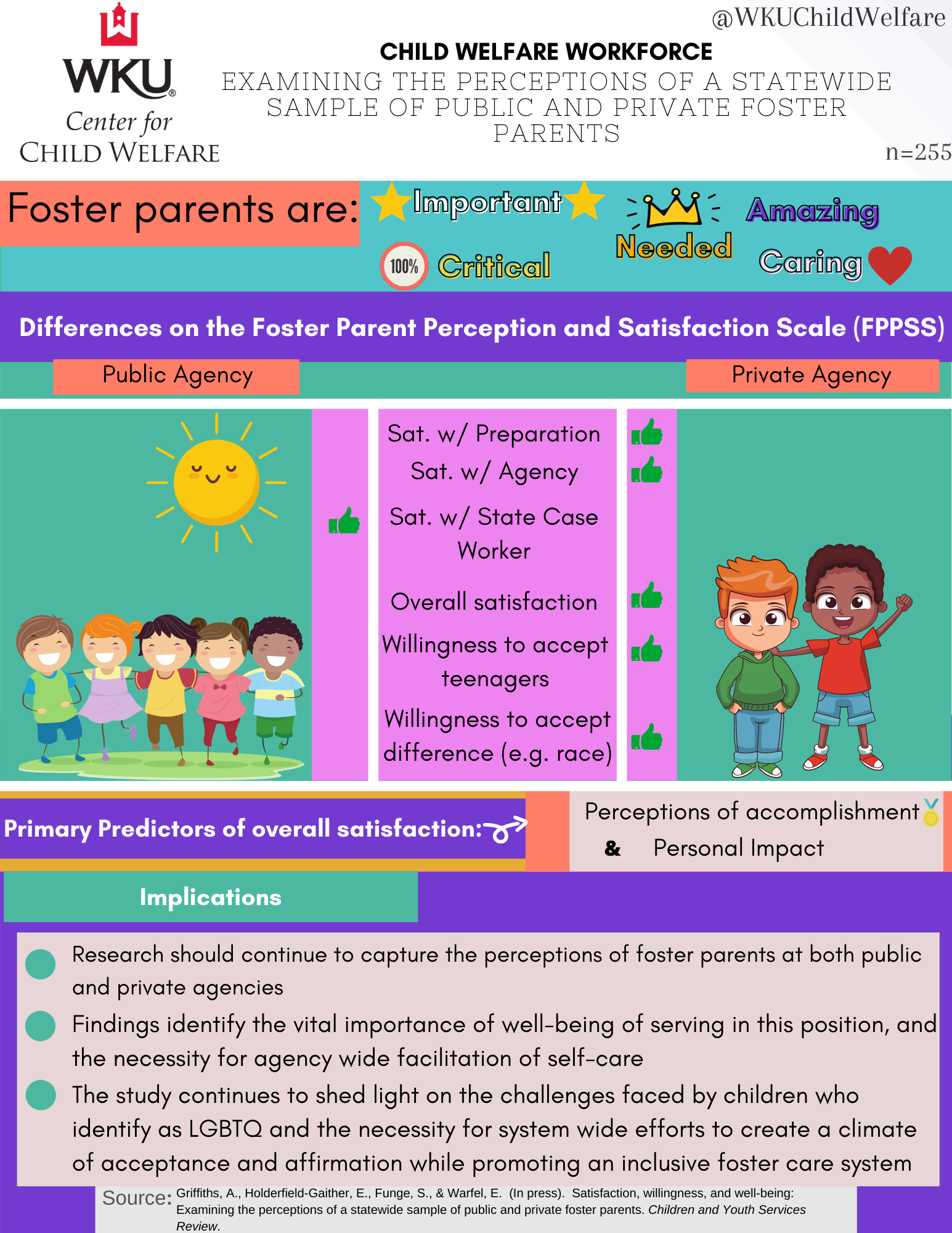
Foster parents are a critical resource and make a significant difference in the lives of children. This article examines the quantitative feedback on the Foster Parent Perception and Satisfaction Scale (FPPSS) from a statewide sample of public and private foster parents (n = 255) in a southern state. Results indicate that perceptions of accomplishment and personal impact were the primary predictors of overall role satisfaction. However, the foster parents’ willingness to accept the placement of a child that is a) LGBTQ or b) different than themselves (e.g. religion, race/ethnicity, and other requested preferences such as age, special need, sibling group) also significantly predicted their overall satisfaction though inversely with respect to LQBTQ foster children. Significant differences were found between the public and private foster parents with respect to their satisfaction with their state caseworker, preparedness, foster agency, overall level of satisfaction, and their willingness to accept the placement of a teenager and of a child with a difference. Implications for training further research with public and private foster agencies are provided.
Griffiths, A., Holderfield-Gaither, E., Funge, S.P., & Warfel, E.T. (2021). Satisfaction, willingness, and well-being: Examining the perceptions of a statewide sample of public and private foster parents. Children and Youth Services Review, 121, 105886. https://doi.org/10.1016/j.childyouth.2020.105886
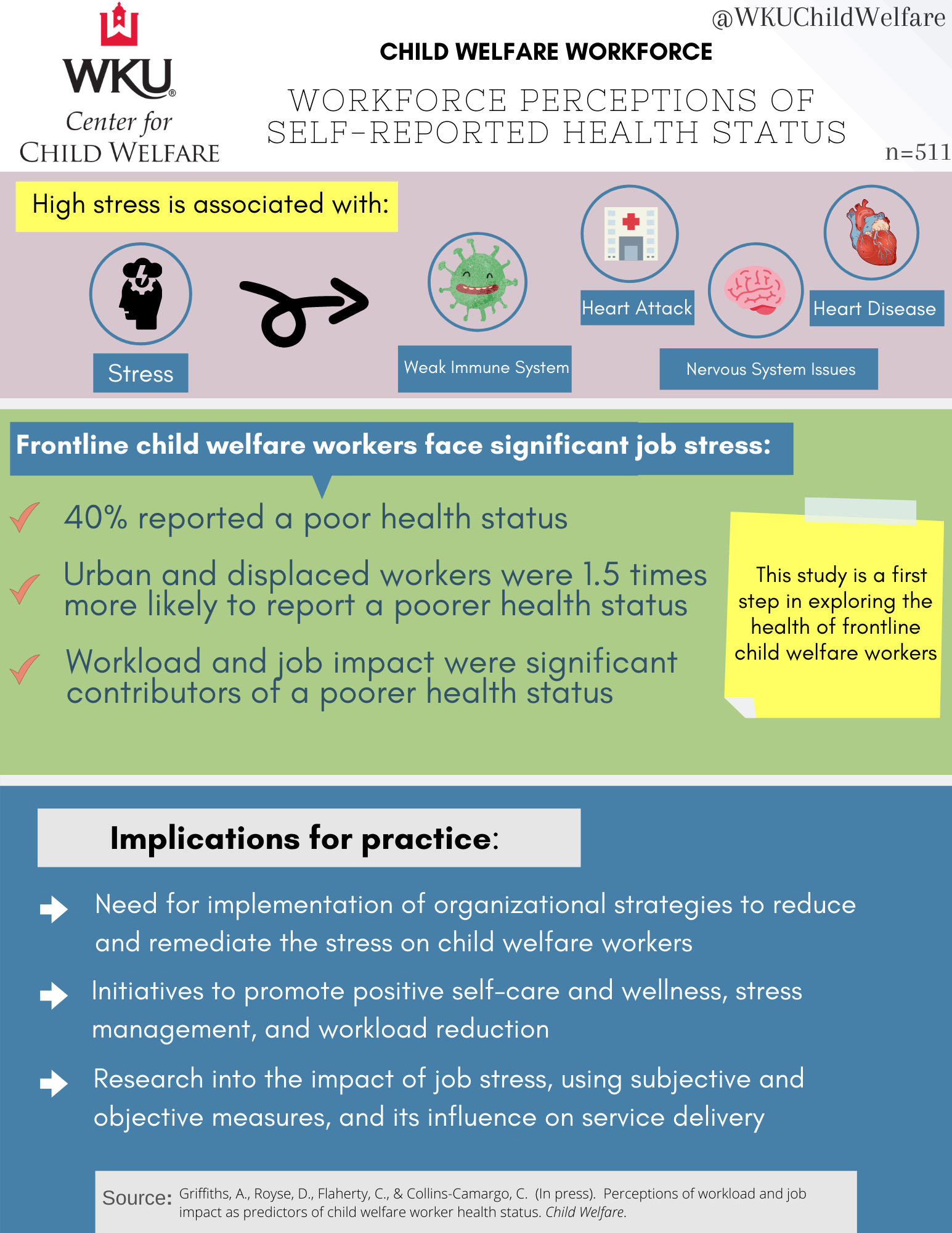
Turnover in the child welfare workforce remains a problem with detrimental consequences. While a robust body of literature has explored the influence of job factors on employee retention, and the presence of secondary traumatic stress and other related experiences in this population, little is known about the impact of such factors on the physical health of the practitioner. This manuscript is a first step in documenting the relationship between worker characteristics, perceptions of their job, and their self-reported health status. Utilizing the Child Welfare Employee Feedback Scale (CWEFS), a Binary Logistic Regression model identified Workload and Job Impact as significant predictors of poorer self-reported health status in a statewide sample of child welfare workers (n = 511). Additionally, respondents working in urban areas and outside of their home county were approximately 1.5 times more likely to report a poorer health status. Findings suggest avenues for future research and agency administrator consideration.
Griffiths, A., Royse, D., Flaherty, C., & Collins-Camargo, C. (In press). Perceptions of workload and job impact as predictors of child welfare worker health status. Child Welfare.
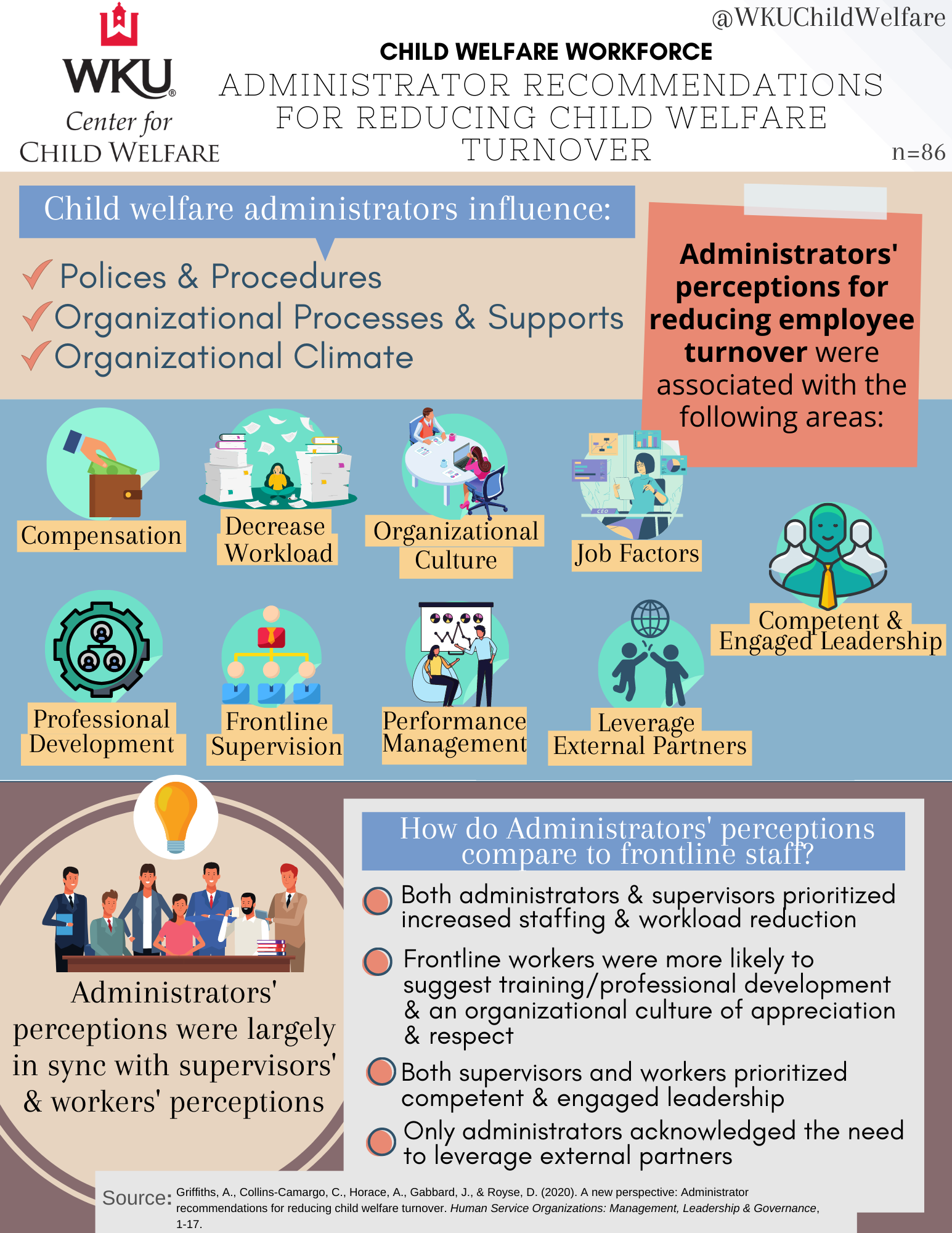
Child maltreatment impacts society on multiple levels, and consistent turnover in the child welfare workforce creates financial challenges and problems associated with service delivery. This study explores the qualitative survey findings from a statewide sample of child welfare administrators in one state (n = 86). When asked to provide suggestions for improving workforce retention, nine overarching themes emerged: compensation, decreased workload, organizational culture, job factors, professional development, frontline supervision, performance management, leverage external partners, and competent and engage leadership. A comparative analysis ensues, where these strategies are juxtaposed with those of frontline supervisors and frontline workers. Similarities, differences, and implications are explored.
Citation: Griffiths, A., Collins-Camargo, C., Horace, A., Gabbard, J., & Royse, D. (2020). A New Perspective: Administrator Recommendations for Reducing Child Welfare Turnover. Human Service Organizations Management Leadership & Governance, 1-17.
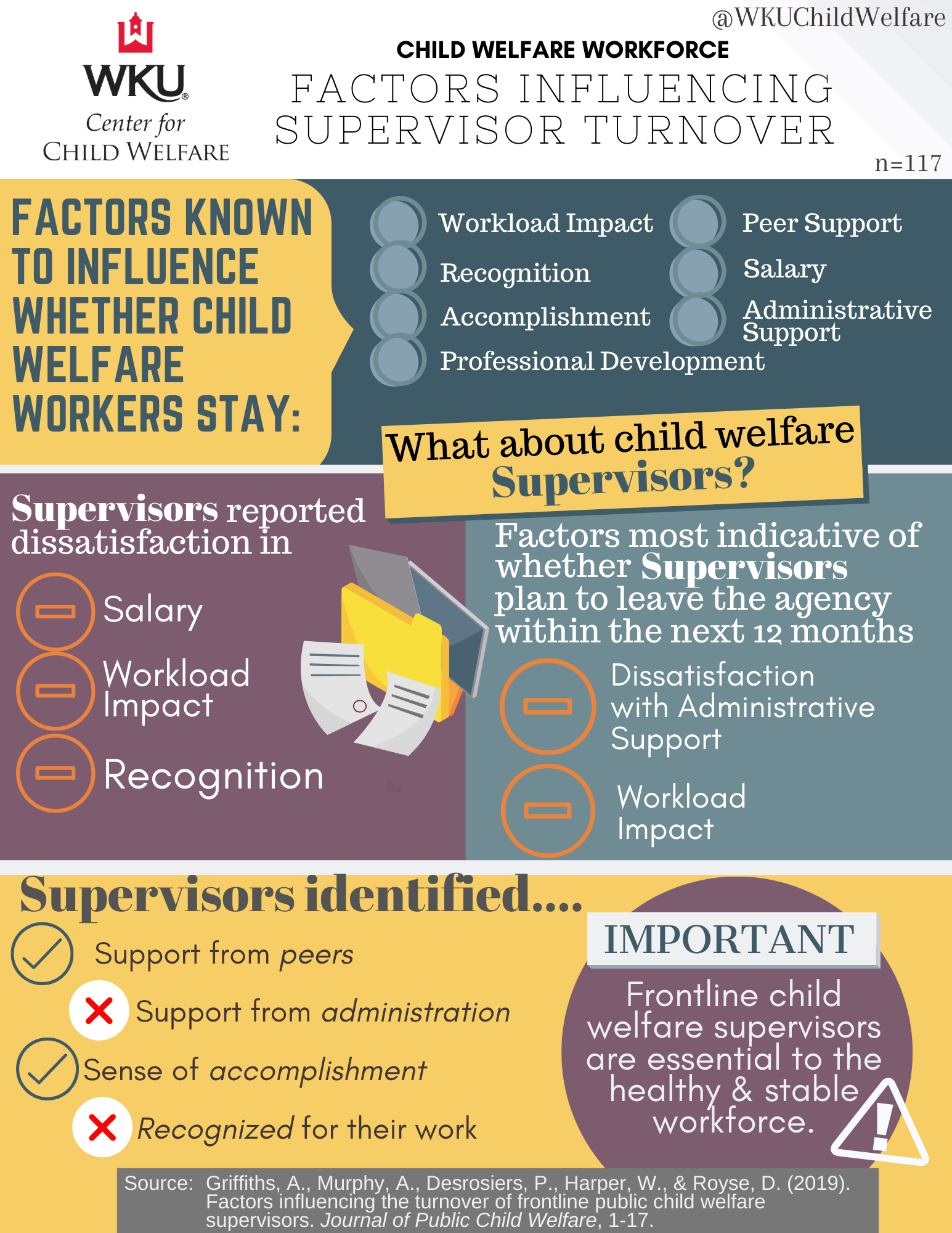
Frontline child welfare supervisors are a vitally important component for providing leadership in service delivery and workforce stability. This statewide study of public child welfare supervisors uses a modified version of a previously developed instrument (the CWEFS) to examine job satisfaction and factors influencing supervisors’ intention to leave. A consistent negative perception of salary was found but a stratified pattern of dissatisfaction emerged across other variables when examined by intention to leave (Stayers, Undecided, and Leavers). A Hierarchical Binary Logistic Regression Model identified two factors that predicted intention to leave: dissatisfaction with administrative support and workload impact. Full Article.
Citation: Griffiths, A., Murphy, A., Desrosiers, P., Harper, W., & Royse, D. (2019). Factors influencing the turnover of frontline public child welfare supervisors. Journal of Public Child Welfare, 1-17.
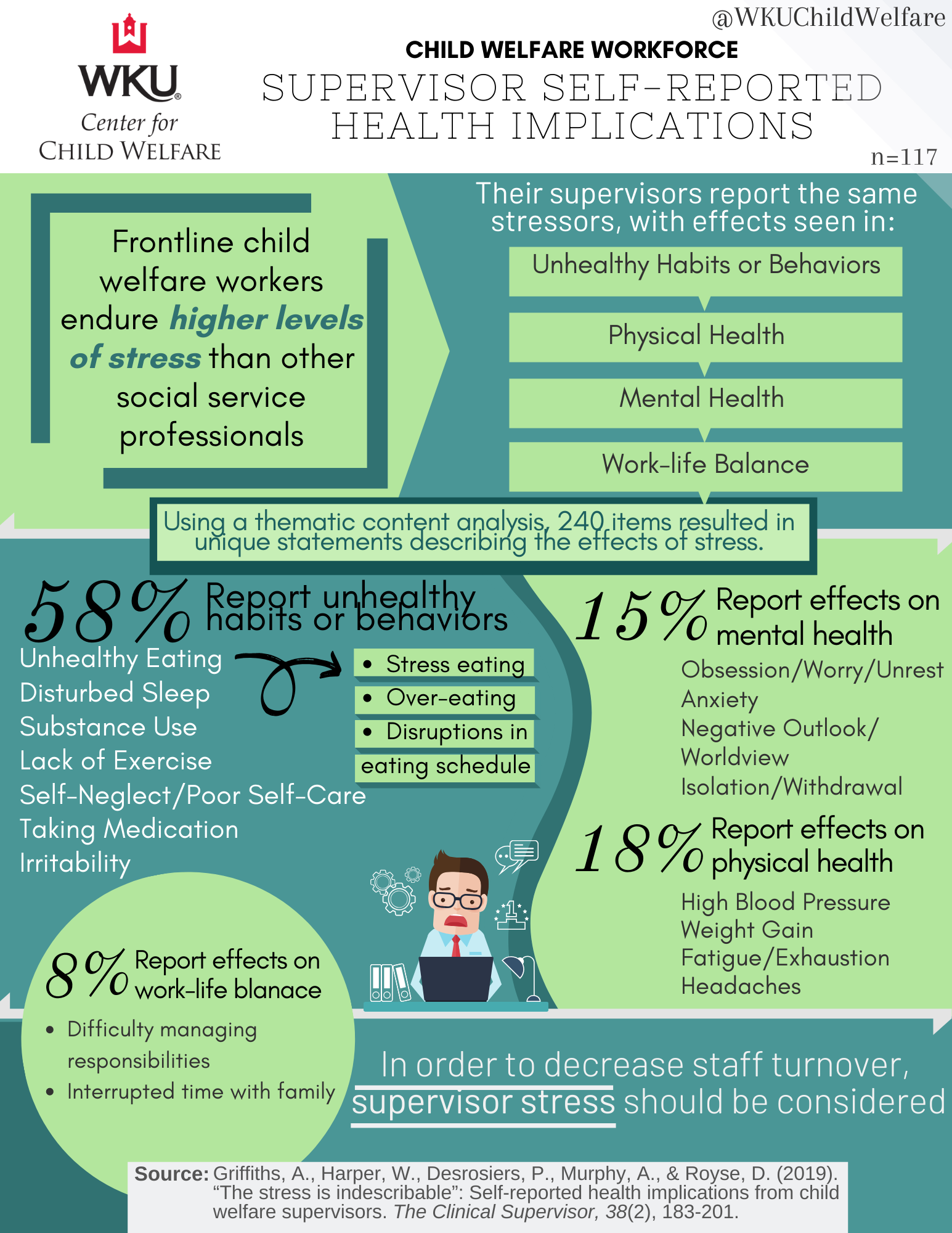
Using data from a state-wide survey of frontline supervisors from a state child welfare agency, this study qualitatively examined how stress from their positions may have affected their perceived health. With a response rate of 44%, 117 frontline supervisors participated and provided 240 comments describing health consequences in their physical health, mental health, work-life balance, and development of unhealthy habits or behaviors. Implications from this study are discussed in the context of workplace stress and employee turnover.Full Article.
Citation: Griffiths, A., Harper, W., Desrosiers, P., Murphy, A., & Royse, D. (2019). “The stress is indescribable”: Self-reported health implications from child welfare supervisors. The Clinical Supervisor, 38(2), 183-201.
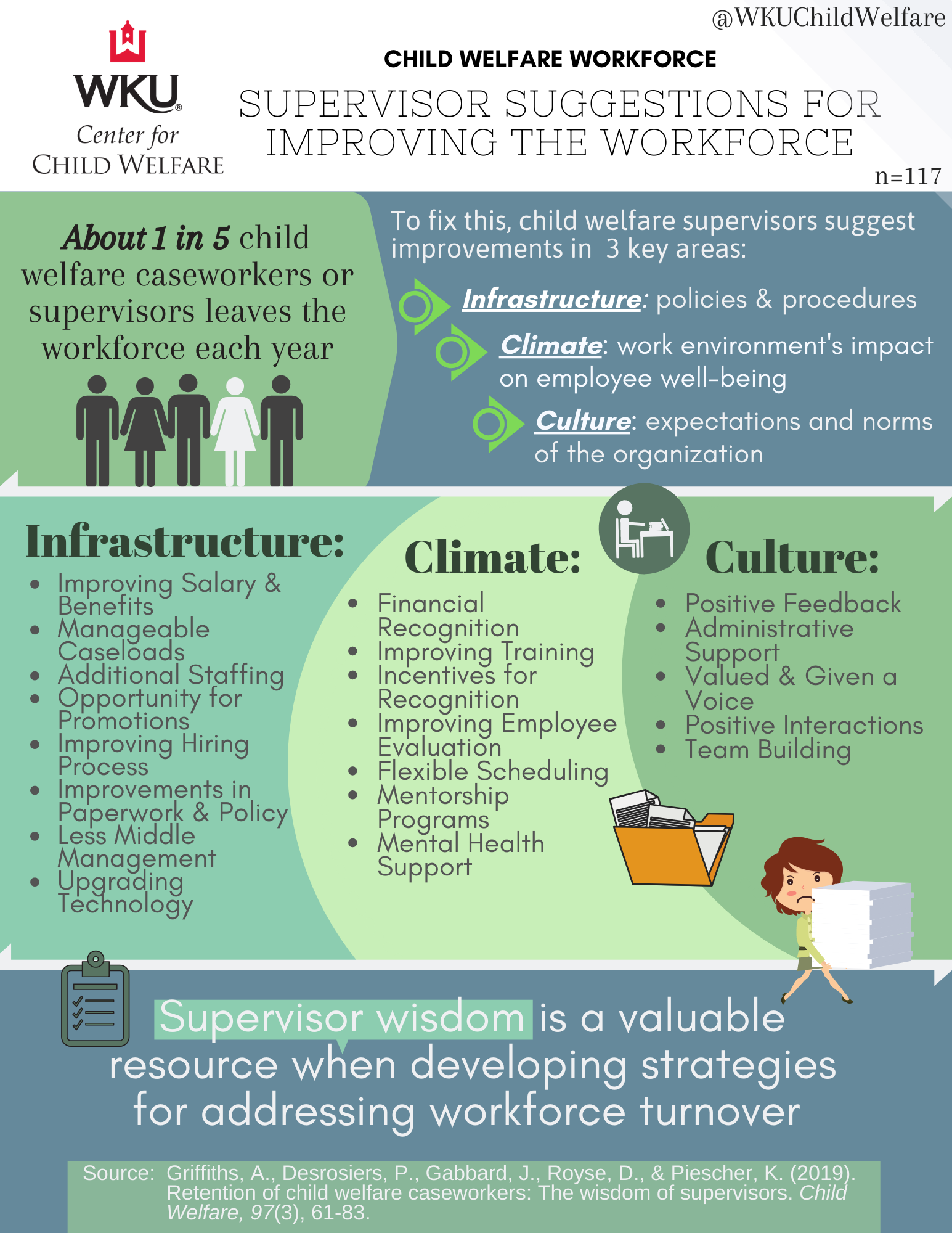
Child welfare supervisors have a unique vantage point, leading local service delivery efforts while representing a larger organizational bureaucracy. They also play a key role in workforce stability, as high caseworker turnover remains a real problem that affects clients, communities, and agency budgets. Using a qualitative thematic content analysis to analyze data collected from a sample of public child welfare supervisors in a southern state (n = 117), findings from this study provide suggestions for systematically addressing workforce turnover through the unique perspective of the child welfare supervisor. Supervisors made recommendations to improve agency infrastructure, organizational climate, and organizational culture as areas for immediate consideration to address this significant problem.
Citation: Griffiths, A., Desrosiers, P., Gabbard, J., Royse, D., & Piescher, K. (2019). Retention of child welfare caseworkers: The wisdom of supervisors. Child Welfare, 97(3), 61-83

Chapter 3: Preparing Child Welfare Practitioners: Implications for Title IV-E Education and Training Partnerships, Austin Griffiths, David Royse, Kristine Piescher & Traci LaLiberte
Citation: Griffiths, A., Royse, D., Piescher, K., & LaLiberte, T. (2020). Preparing child welfare practitioners: Implications for Title IV-E education and training partnerships. In P. Leung, P. & M. Cheung (Eds.), Title IV-E child welfare education: Impact on workers, case outcomes and social work curriculum development (pp. 49-67). Routledge.
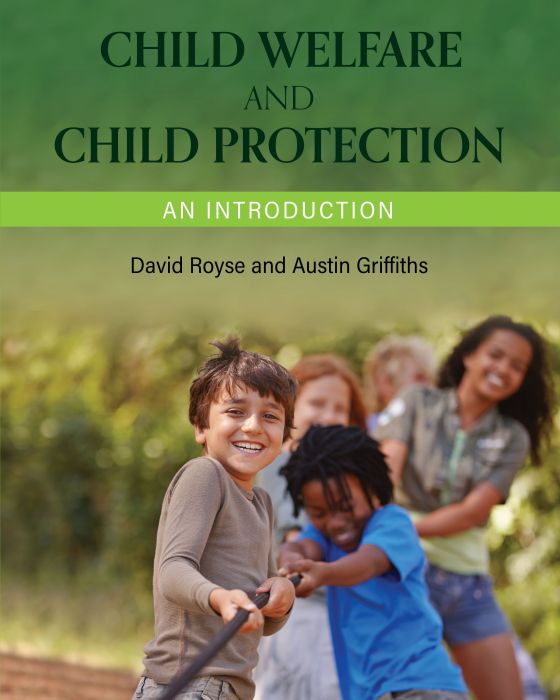
Child Welfare and Child Protection: An Introduction prepares future child welfare professionals to tackle the complex and challenging work associated with responding to child maltreatment. Developed by a former child protection professional and a social work scholar, this book draws upon current research and features cases that simulate those child welfare professionals are likely to encounter in the field.
Find us on Social Media | @WKUChildWelfare






